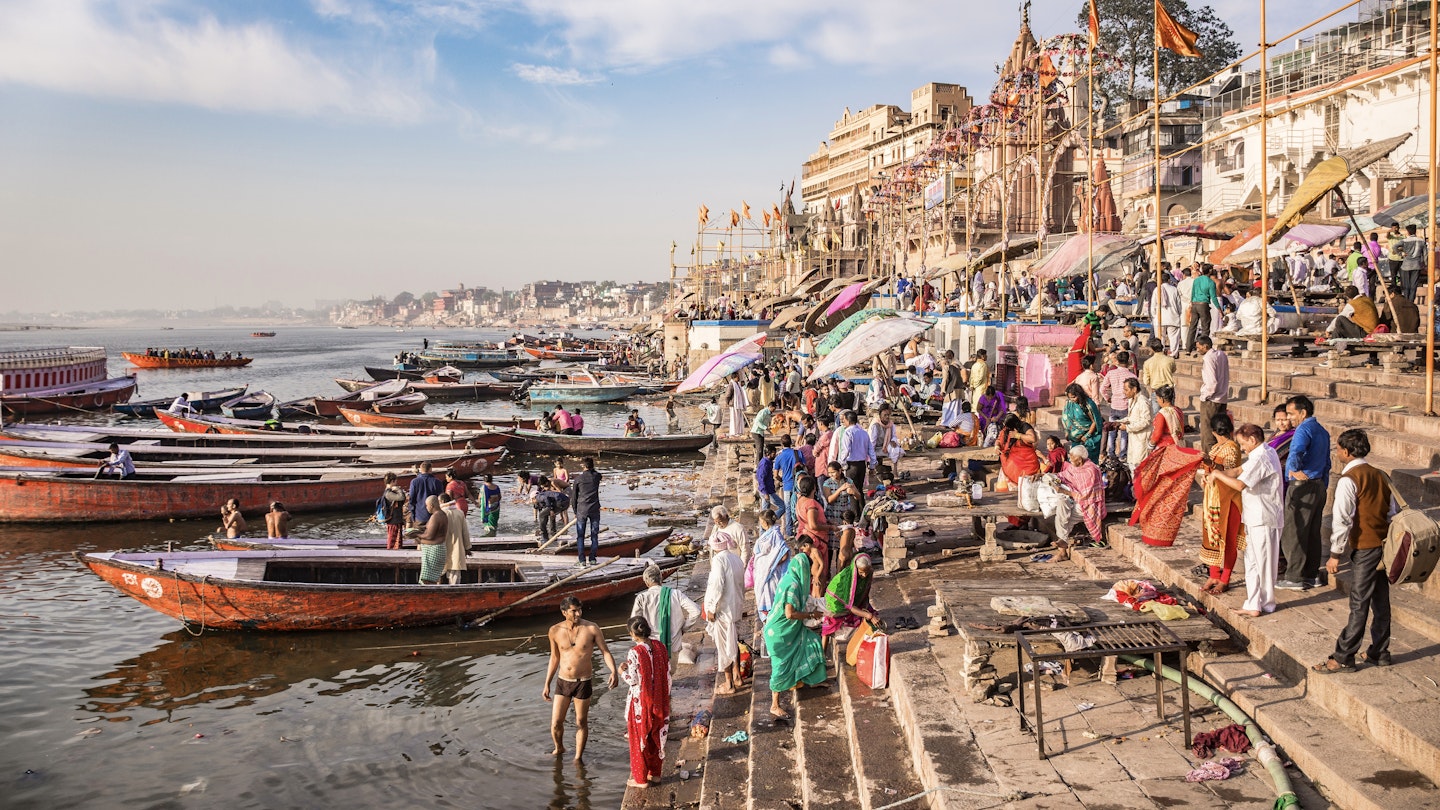Varanasi looms large in the minds of anyone contemplating a trip to India.
The deep faith traditions evident at every ghat, the photogenic colors, and the tableau of humanity that comes to partake of the Ganges’ sacred waters here make Varanasi a magnet for spiritual seekers, intrepid travelers, and documentary filmmakers alike.
This is India at its most intense.
Varanasi attracts tens of millions of visitors every year. Pilgrims come here from across India to commune with the sacred Ganges and mark life’s great turning points: birth, marriage, and (most famously) death. For Hindus, Varanasi is the holiest place in India to be cremated and offers the chance to achieve moksha, or a final release from the cycle of death and rebirth. Outdoor cremation ghats operate around the clock on the banks of the Ganges.
All this means that a visit to Varanasi inevitably includes a reckoning with the realities of life and death. How can that not move and leave a deep impression on any visitor?
When Should I Go to Varanasi?
The best time to visit Varanasi is from October to March. During the monsoon (July to October), the city experiences torrential rains, and the Ganges swells, often flooding low buildings. The river levels can rise up to 12m (40ft).
During the wet season, many ghats become inaccessible, making a riverside walk challenging. You can access the ghats between April and June; however, these months can be oppressively hot, with temperatures reaching 45°C (113°F).
How Much Time Do I Need to See Varanasi?
Allocate at least two days but consider staying longer. While there are only a handful of must-visit sights, the city’s atmosphere can draw you in for more time. An extra day trip to Sarnath, where Buddha gave his first sermon, is also recommended.
Is It Easy to Get In and Around Varanasi?
Varanasi is well connected to other parts of India by bus, train, and air. Taxis and auto rickshaws operate in town but cannot access the Old City due to narrow alleys (galis) that are best explored on foot.
Where Should I Stay in Varanasi?
Staying in the Old City may require navigating through narrow lanes, while accommodations in the new town tend to be more vehicle accessible. Check with your accommodation for details.
Top Things to Do in Varanasi
Wake Up Early to Witness Dawn on the Ganges
A river trip at dawn or dusk is essential to experience the city from the water. The early-morning light is inspiring, with devotees bathing and performing puja (prayers).
Pay Your Respects to “Mother Ganga”
Every day at sunset, the aarti ceremony pays tribute to the goddess and the river. The ceremony involves priests performing rituals with sacred objects that represent the five elements.
Sample the Best Lassi in Town
For a delicious lassi, seek out local vendors, with many competing for the title of best. The lassis served here are creamy, fresh, and adorned with a colorful array of toppings. Truly a must-try delicacy!
Do Yoga on the Ghats
Practicing yoga in Varanasi at dawn, with the light touching the ghats, is an enriching experience. Various institutions offer outdoor classes during this peaceful time.
My Favorite Thing to Do in Varanasi
My first experience on the ghats was exhilarating. Varanasi’s 84 ghats cluster together, offering a rich tapestry of life. Walking along the river’s edge, past temples and bustling locals, immerses you in the city’s ancient rhythms.
How Much Money Do I Need in Varanasi?
Varanasi offers options for travelers of all budgets. With a recent boom in tourism, the city has seen an increase in luxury accommodations and dining without losing its budget-friendly options.
- Hostel room: ₹800–1200 (US$10–15)
- Basic room for two: ₹1200–5000 (US$15–60)
- Luxury hotel: ₹5000+ (US$60+)
- Auto rickshaw from the train station to the Old City: ₹200 (US$2.50)
- Lassi: ₹60 (US$0.70)
- Thali meal: ₹200 (US$2.50)
- Dinner for two in a mid-range restaurant: ₹500 (US$10)
Things You Should Know in Varanasi
Respect the Cremation Workers
The Dom community tends to the cremation ghats, a role that comes with significant challenges. Be mindful of their work as you observe the rituals.
Count on Smoking Bhang, But Not Drinking Alcohol Near the Ganges
While bhang is widely available due to its cultural significance, drinking alcohol, especially near the Ganges, is frowned upon in this deeply spiritual area.
Prepare to Haggle
Like elsewhere in India, haggling is common when negotiating fares. Agree to a price beforehand and avoid being taken to shops or hotels where drivers receive a commission.
Mind the Marauding Monkeys
Monkeys are common in the Old City and can be aggressive, particularly if they see food. Maintain a safe distance and secure your belongings, especially when leaving your accommodation.





